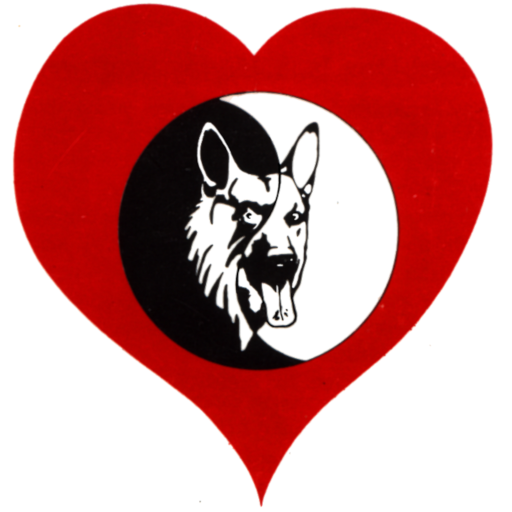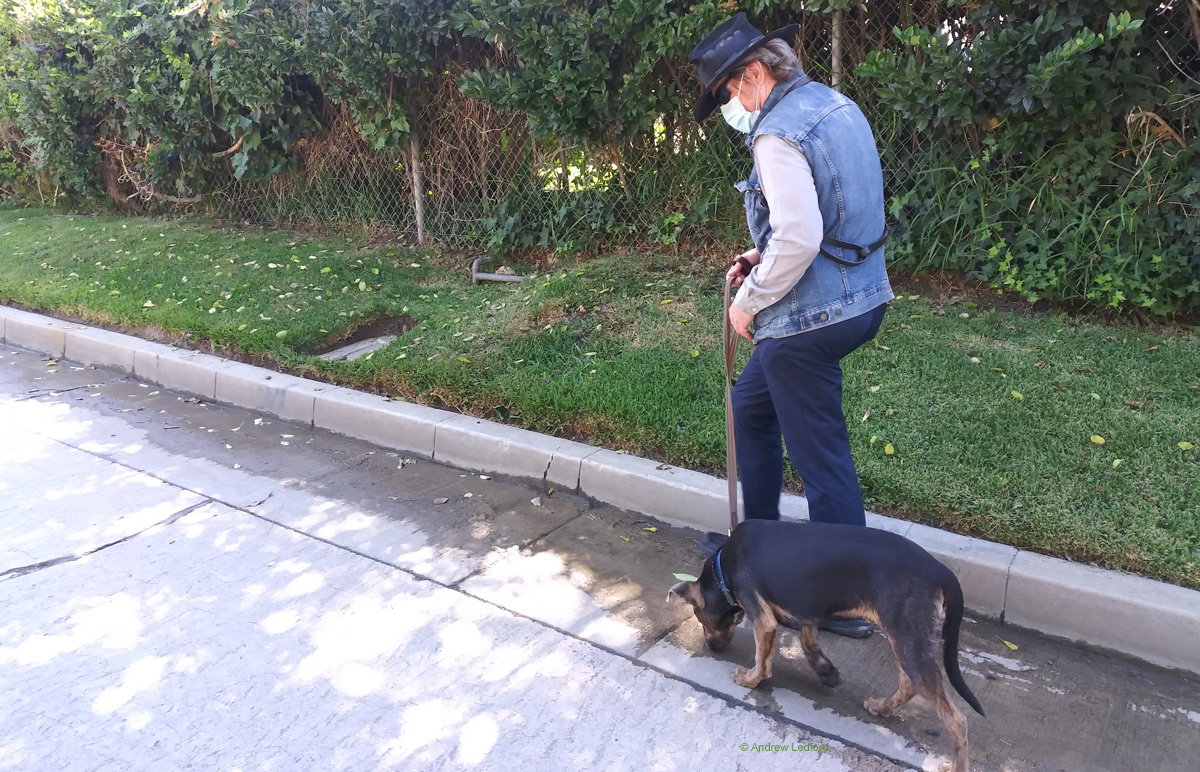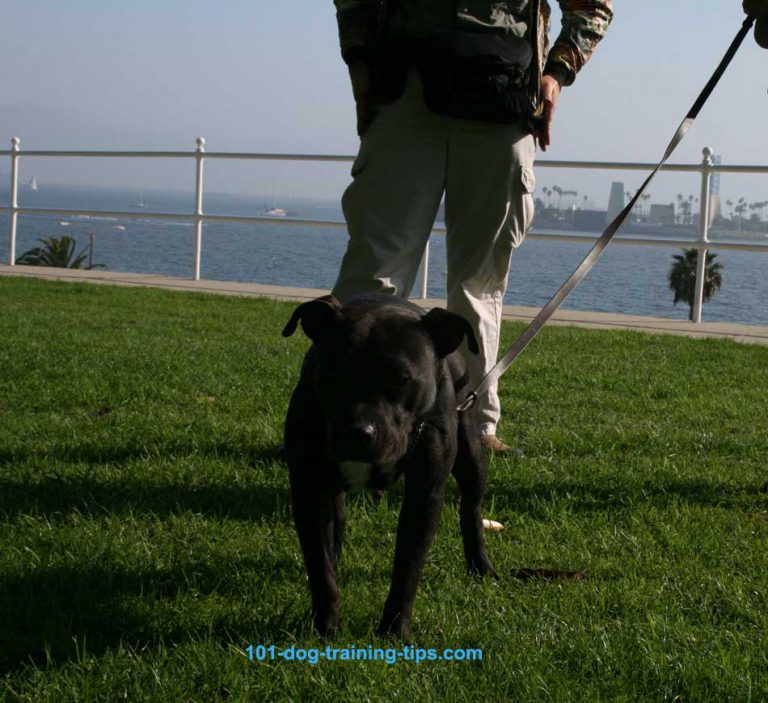How To Train Dogs to be comfortable around people wearing a facemask
Training Dogs to be comfortable around people wearing a face mask is part socialization, part training, and part handling.
We’ll start with general information about why we may need to train a dog to accept face masks. The training techniques are about one third down the page and comprise the second half of the article.
Many dogs are quite sensitive to novel visual stimuli. This especially true during the first year of Covid-19 when wearing a facemask was novel.
When novel stimuli is animated it’s more stressful. Stress and fear is compounded when the novel element is added to another living being. I use novelty as part of my initial temperament evaluation when I start working with a new dog. Generally with a new dog I will approach the dog with my briefcase while wearing my cowboy hat and then interact with forceful play. In the past I would wear a black and white jacket for initial temperament evaluation as well. A facemask was good for testing, but now accepting people in a face mask is a standard canine life skill.
A face mask is so out of place in America that most dogs have never been socialized to masked humans.
Masks and other out of place clothing and looks.
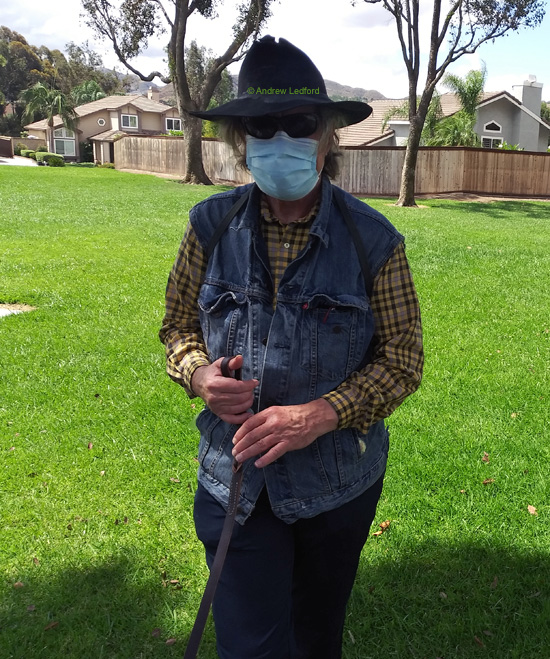
A dog can be fearful of any kind of novel clothing. So it’s not just masks, but any type of clothing that’s out of place in the dog’s world. I have seen dogs that don’t like people in suits and others who really don’t like the rougher biker look. Another facial covering some dogs don’t like are beards. Some facemasks may trigger a bigger reaction than others. I have not tested it, but from years of observation, I would say dark masks with teeth on them are much more threatening than standard blue paper masks.
If we ever get back to normal we’ll still need to be aware of our dog’s behavior around novel people during holidays and celebrations like Halloween. I always recommend young puppies are exposed to people in uniform. You don’t want your dog biting the paramedic that responds to help in emergencies.
Many Californian dogs don’t particularly like my cowboy hat, but they usually adjust to it fairly quickly. So far I’ve noticed that face masks are not accepted as readily as my hat, which I find fascinating. I need to mention I have only interacted with a few dogs and a few owners since the stay at home orders. However, I have had the chance to observe my neighbor’s dogs and a few others, and have interacted with a few dogs that don’t know me.
I have heard others mention one reason dogs are more fearful of masked people is that masks hide a major form of communication. It prevents dogs from seeing what we mean, whether we are friend or foe. This is because our faces give a lot of subtle cues to the dog about the social situation and our mood. This could be true, but I don’t think it’s the whole story.
If you have been through one of my training programs you have the tools to communicate with your dog in very clear terms, even if the dog can’t see your face. This is accomplished with well-defined hand signals we train for, as well as the body language, use of body positioning, and eye contact.
Face mask Acculturation
The reason I don’t agree with the loss of communication signals being the reason for the fear of face masks is, I never noticed this fear of masked people when I was observing and training dogs in Taiwan or while visiting Japan. In Asia it’s much more common to wear a face mask and most dogs have been exposed and socialized to people with face coverings.
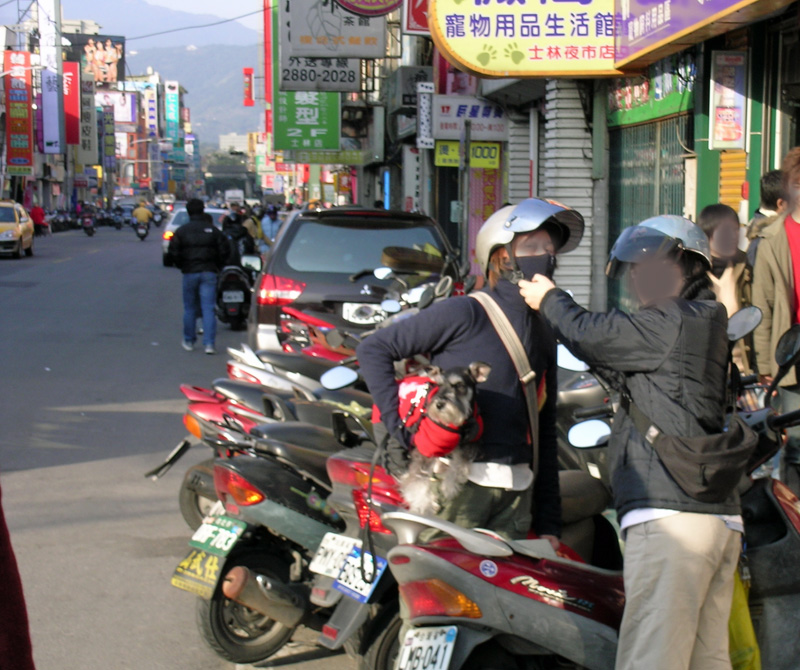
If you have a young pup do your mask training as it is growing through the socialization sensitive periods, up to about 14 weeks.
If you have a puppy make sure to wear your mask around the dog before its three months old and even after this time. A good mask training exercise is to work on basic dog training drills using food while masked. If you do this, putting the face mask on will mean fun treats instead of a scary new experience.
For dogs with some retrieve drive I would also recommend playing retrieve while wearing a mask and other face coverings.
Some other facial coverings we can work with are face shields and even bandanas. All of these should help make the dog a bit hardier when interacting with unusually dressed people, those in uniform, and costumed children.
How To Train Dogs to be comfortable around people wearing face mask
Beginning face mask training for moderately sensitive dogs
To begin your training try to make the mask a positive cue to the dog. To do this, good things must happen when you’re masked. The next step is to start training with people that are not regular caretakers, who the dog knows, and ideally they should have some kind of a bond with the dog.
If your dog is too sensitive to start training at the level described next go to the end of the article and begin with the
How to start training a very sensitive dog to accept people wearing masks.
Face mask training
Put on your face mask and do food training or take the dog for a walk if they like walks. If your dog likes to retrieve then play retrieve with its favorite toy.
Another exercise you’ll want to work extra hard on is the recall, calling your dog to you. A lot of dogs I work with show at least some hesitation and avoidance when called. If your dog is not used to you wearing a mask this avoidance will be heightened. If you’ve been through or are in one of my training programs, do the beginning handling exercises using food. Start by touching the dog while using food just like you are starting from the beginning.
A little refresher – let the dog lick and nibble at the food then touch the dog on a sensitive area, such as the muzzle, lips, occipital ridge, paws, or tail, after the touch give the command “Take” and let the dog have the food.
If the dog shows signs of avoidance, it pulls away, then you need to lure the dog towards you, using the food.
Next work on the basic commands using food. I suggest doing this training even if your dog is very reliable. For dogs that are already trained, make sure the rewards are on some kind of variable schedule. A simple way to schedule reinforcement is to only reward your dog’s best responses.
When your dog is quite comfortable working with you, have a friend the dog knows do the training. Don’t expect your friends and relatives to be able to read the dog or have the proper timing. They may even reward the wrong behavior at times, at this point that’s okay. It’s more important the dog has a good experience with masked people outside the immediate household.
Train your dog to accept people in masks out in the community
Now we get to train in the community. Start working your dog on the basic obedience exercises while out on walks and look for people wearing face masks. When you first start training in the community keep your distance from people. Keep in mind that distance equals safety. Your dog will be less stressed if you have more distance between you and the unusual person or object. Some dogs need to be 6 to 8 feet away and others need considerably more distance. Perhaps your dog needs a 100 feet or even 200. Start with what your dog is comfortable with and work towards improvement.
There are a couple of strategies at this point. If possible we will incorporate some reward based training for these socialization and acceptance exercises. If your dog is already fairly accepting of people in masks, for a day or two you can reward your canine kid when it responds to a command when out seeing mask wearers. Ideally reward the dog after it has oriented to the mask wearer and then reorients and focuses on you. What we want to see is normal relaxed body language.
For those who have been through my training program this would be a good time to work on a stationary “Heel,” touching, and the “Off” command. One exercise that I like and that all dog trainers teach is the recall or “Come” (“Here”) exercise. So this is also a good time to work on the recall for food. In this scenario the AKC recall is preferable, where the dog sits in front of you, as opposed to the military recall where the dog ends up in a Heel position. If you have worked with me you should be doing an AKC style recall with either an AKC or military finish, no matter what breed you have. If you have a protection trained dog you should contact your trainer for advice on this problem. Many protection dogs are taught to go into the Heel position on recall.
Some aggressive dogs may need to wear a muzzle if they pose a risk to others.
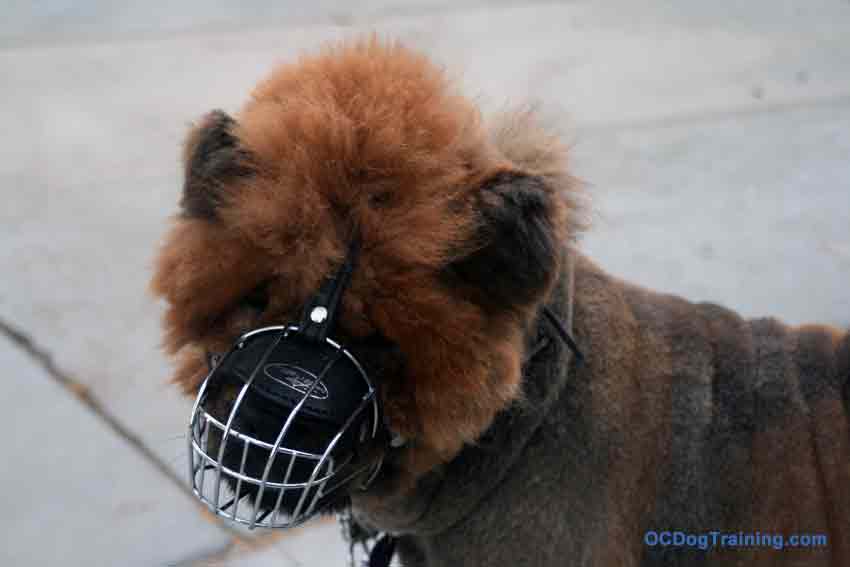
Dog Handling Tip
If you need to call your dog in an emergency consider taking off your mask to eliminate one possible aversive variable in what could be a stressful scenario.
Food and Treats – lets do cookie training.
If your dog is usually food motivated and will not take food around people in face masks, it means the dog is stressed over the threshold of comfort. Here food can be used as much for gauging stress as it is for training. If a food motivated dog doesn’t want food, then the first step is to get the dog to take food when exposed to people wearing masks. You need to find at what distance that is. Move far enough away from masked people that the dog will take food, but is still aware of their presence. When at the proper working distance do fairly easy training exercises the dog already knows. Gradually get closer to mask wearers as the dog becomes more confident.
One thing you need to keep in mind while working with a stressed dog, “don’t act stressed yourself.” If you act worried it will only confirm in the dogs mind that it was right in being overly concerned about the situation. You must convey confidence and be the pillar of stability in your dog’s world.
I have seen a lot of well trained dogs do quite poorly in obedience trials because the owner/handler was acting stressed.
You need to work in situations where you feel confident in your abilities to convey to the dog that there is no need to worry. Then push just a little each day. You also need a plan for the unexpected. What will you do if there is a situation you did not plan on? How will you deal with people suddenly appearing who the dog may be fearful of?
One technique may be to go into an obedience exercise where you are doing training drills in very rapid succession with multiple behavior in a very short period of time. Another may be calmly crossing the street and then doing reward training. I often move up a driveway and immediately go into doing a training drill. If you’re working in a driveway to increase the distance, remember that the dog will want to face the threat or object of interest. In general it will be easier to control the dog if it’s facing the subject of interest. However, it will show you have more control if you get willing compliance when the dog is facing away from the subject of interest.
How to start training a very sensitive dog to accept people wearing masks.
Desensitizing your sensitive dog to people wearing facemasks.
Some dogs are extremely sensitive to the new normal of mask wearing. For these sensitive dogs we can do a more extensive systematic desensitization training program.
With this kind of training we start teaching the dog not to be afraid of the scary object in the least frightening way possible.
If you need to do this training start by letting the dog get accustomed to the mask before you wear it. I would start by letting the dog smell the mask. It may be helpful to use a mask you have been wearing, so it will have your scent. You may also want to pet the dog with the mask as though it was a grooming glove. If your dog is afraid of being touched with the mask then incorporate this into a handling exercise using food. With this type of training use as many of the senses as possible. You’ll be desensitizing the gestalt of the fear evoking experience. Next I would hold the mask up in the same position as wearing it but not in front of my face. Most dogs will be fine with this, however if your dog is extremely sensitive move to a less stressful exercise.
Next I would hold the mask in front of my face and if the dog was well trained to sit give the “Sit” command. It is okay to use a food lure at this point. Make sure to give the food reward and praise. If your dog is not trained to sit, then I would sit on the floor and put a high value treat in front of me and as the dog was approaching I would hold up the mask in the same position as wearing it but not in front of my face. If the dog is not stressed by holding the mask up in this fashion I would next do the same routine of placing food in front of me but this time hold the mask in front of my face. Even if the dog shows few or no signs of stress with these drills I suggest doing at least three rewarded trials of the exercise before moving to the next. When the dog shows no hesitation or stress at this level I would then hold the mask against my face and then put the mask on.
Next work at getting the dog comfortable coming to you while you are already wearing the mask and sitting on the ground. Next step is to perform this exercise while kneeling and then standing. At this point you should be able to wear the mask around the house without undue stress on the dog.
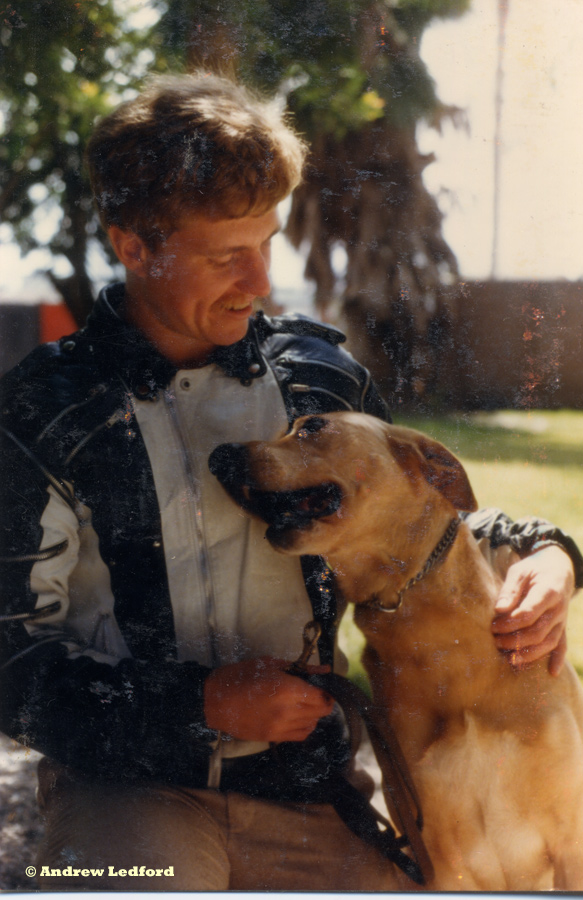
The next step is to get the dog to take food from other masked humans, start with someone the dog knows. You may need to have them do some of the training sitting on the floor, at this stage they should be able to move through the training progressions quickly. When comfortable with people the dog knows you can go back and work on the exercises I mentioned for the less sensitive dogs.
Each phase of this training may take anywhere from one training session or many. Go at your dog’s pace. Don’t try to push too quickly or you may take longer to reach your goal.
Try to make training fun and don’t get frustrated. I often treat dog training like a game where each improvement or closer approximation to the goal behavior allows me to Level Up to acquiring new skills.
When the dog is good at these exercises you can go back to the previous exercises I outlined for training dogs out in the community
If you need additional help give me a call. All calls are now going to my Google voice so state your name and if I don’t answer leave a message and I will call back as soon as possible.
714-827-4058
Andrew Ledford
